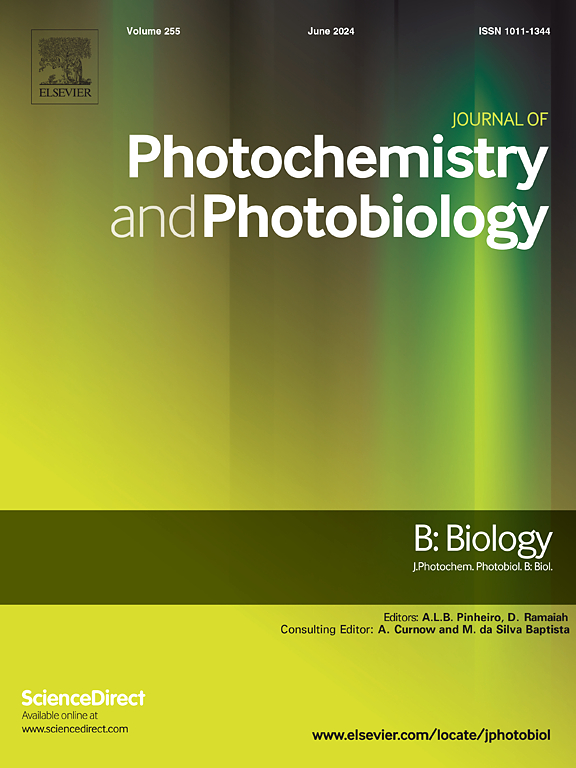牛精液中阿尔法疱疹病毒 1 的光消毒
IF 3.9
2区 生物学
Q2 BIOCHEMISTRY & MOLECULAR BIOLOGY
Journal of photochemistry and photobiology. B, Biology
Pub Date : 2024-09-24
DOI:10.1016/j.jphotobiol.2024.113036
引用次数: 0
摘要
生殖生物技术作为牛育种的一种方法已得到广泛应用,并对牛群的遗传改良产生了重要影响。精液是繁殖过程中病原微生物传播的重要来源。为确保精液的卫生质量,必须考虑到包括病毒在内的各种微生物的存在。牛α-疱疹病毒 1(BoHV-1)是引起牛鼻气管炎和外阴阴道炎的病原体,经常与母牛和公牛的繁殖效率有关。在人工授精中心,精液处理一般只使用抗生素,而忽略了灭活其他非细菌感染病原体的可能性。在这种情况下,光消毒成为一种很有前途的替代方法,可灭活多种微生物,是传统精液处理方法的补充或替代方法。在这项工作中,我们评估了使用四种卤代磺化卟啉作为潜在光敏剂(PSs)对牛α疱疹病毒 I(BoHV-1)进行光动力灭活以消毒牛精液的情况。研究人员合成了这些光敏剂,并展示了它们的光物理参数,如紫外-可见吸收光谱和单线态氧量子产率(ΦΔ)。首先在细胞培养中显示了对 BoHV-1 的光灭活作用,然后在人工感染的牛精液中证实了这一作用,接着评估了 PSs 对精子的光毒性。所有 PSs 都能有效灭活 BoHV-1,但含有两个氯原子的光敏剂由于完全灭活病毒所需的时间更短,因此效率更高。观察到精子动力学发生了轻微变化,但仍在动物繁殖监管机构可接受的范围内。虽然这项工作中使用的方法只包括牛精液,但我们强调,所建议的光消毒方法可以调整并应用于动物或人类感兴趣的各种生物材料和微生物。本文章由计算机程序翻译,如有差异,请以英文原文为准。
Photodisinfection of Alphaherpesvirus 1 in bovine semen
Reproductive biotechnologies are widely consolidated as a methodology in cattle breeding and have an important impact on the genetic improvement of cattle herds. Semen is an important source of dissemination of pathogenic microorganisms during reproductive procedures. To ensure the sanitary quality of the semen, it is essential to consider the presence of various microorganisms including viruses. One of the main viral agents of reproductive interest is Bovine Alphaherpesvirus 1 (BoHV-1), the etiological agent responsible for bovine rhinotracheitis and vulvovaginitis and frequently associated with reproductive efficiency of matrices and bulls. In artificial insemination centers, semen treatment is generally based only on the use of antibiotics, ignoring the possibility of inactivating other non-bacterial infectious agents. In this context, photodisinfection emerges as a promising alternative to inactivate a wide range of microorganisms, offering a complementary or substitution approach to those conventional semen treatment methods. In this work, we evaluated the use of four halogenated sulfonated porphyrins as potential photosensitizers (PSs) for photodynamic inactivation of Bovine Alphaherpesvirus I (BoHV-1) for bovine semen disinfection. The PSs were synthesized and photophysical parameters, such as UV–Vis absorption spectra and singlet oxygen quantum yield (ΦΔ) were presented. Photoinactivation of BoHV-1 was first shown in cell culture and then confirmed in artificially infected bovine semen and then the phototoxicity of PSs against spermatozoa was evaluated. All PSs were effective in BoHV-1 inactivation; however, the photosensitizer containing two chlorine atoms, showed to be more efficient due to the shorter time required for complete viral inactivation. The slight alterations in sperm kinetics were observed, but remained within those acceptable by regulatory agencies for animal reproduction. Although the methodology used in this work only included bovine semen, we emphasize that the proposed photodisinfection methodology can be adapted and applied to a wide range of biological materials and microorganisms of animal or human interest.
求助全文
通过发布文献求助,成功后即可免费获取论文全文。
去求助
来源期刊
CiteScore
12.10
自引率
1.90%
发文量
161
审稿时长
37 days
期刊介绍:
The Journal of Photochemistry and Photobiology B: Biology provides a forum for the publication of papers relating to the various aspects of photobiology, as well as a means for communication in this multidisciplinary field.
The scope includes:
- Bioluminescence
- Chronobiology
- DNA repair
- Environmental photobiology
- Nanotechnology in photobiology
- Photocarcinogenesis
- Photochemistry of biomolecules
- Photodynamic therapy
- Photomedicine
- Photomorphogenesis
- Photomovement
- Photoreception
- Photosensitization
- Photosynthesis
- Phototechnology
- Spectroscopy of biological systems
- UV and visible radiation effects and vision.

 求助内容:
求助内容: 应助结果提醒方式:
应助结果提醒方式:


